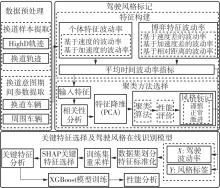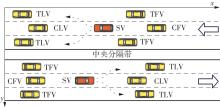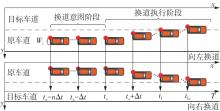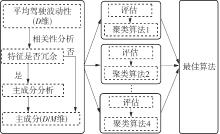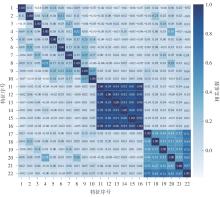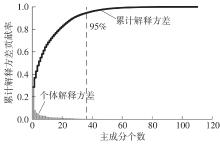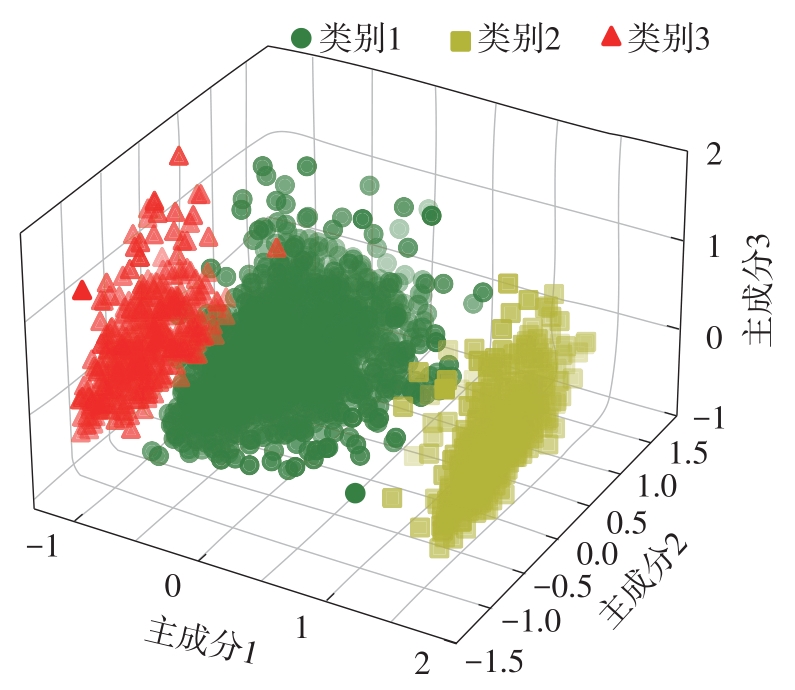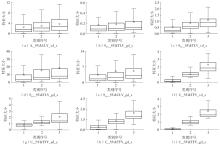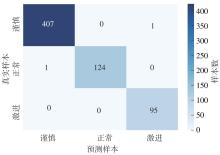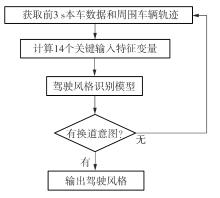Journal of South China University of Technology(Natural Science Edition) ›› 2024, Vol. 52 ›› Issue (4): 126-137.doi: 10.12141/j.issn.1000-565X.230159
• Traffic Safety • Previous Articles Next Articles
Online Driving Style Recognition Method Considering Lane-Changing Game
ZHANG Yunchao1 HUANG Jianling2 LI Yongxing1 CHEN Yanyan1 YANG Anan2 ZHANG Yongnan1
- 1.Beijing Key Laboratory of Traffic Engineering, Beijing University of Technology, Beijing 100124, China
2.Beijing Intelligent Transportation Development Center, Beijing 100027, China
-
Received:2023-03-30Online:2024-04-25Published:2023-06-07 -
Contact:陈艳艳(1970-),女,博士,教授,主要从事智能交通研究。 E-mail:cdyan@bjut.edu.cn -
About author:张云超(1994-),男,博士生,主要从事道路交通安全研究。E-mail:zhangyunchao@emails.bjut.edu -
Supported by:the National Natural Science Foundation of China(62203021)
CLC Number:
Cite this article
ZHANG Yunchao, HUANG Jianling, LI Yongxing, et al. Online Driving Style Recognition Method Considering Lane-Changing Game[J]. Journal of South China University of Technology(Natural Science Edition), 2024, 52(4): 126-137.
share this article
Table 2
Initial parameters used for driving style identification"
| 特征类型 | 特征序号 | 特征名称 | 特征含义 | 单位 |
|---|---|---|---|---|
| 个体操作行为特征 | 1 | xVelocity | 车辆在X轴方向上的速度 | m/s |
| 2 | yVelocity | 车辆在Y轴方向上的速度 | m/s | |
| 3 | xAcceleration | 车辆在X轴方向上的加速度 | m/s2 | |
| 4 | yAcceleration | 车辆在Y轴方向上的加速度 | m/s2 | |
| 博弈行为特征 | 5 | SV&CLV_vd_x | SV&CLV在X轴方向的速度差 | m/s |
| 6 | SV&CLV_vd_y | SV&CLV在Y轴方向的速度差 | m/s | |
| 7 | SV&CLV_ad_x | SV&CLV在X轴方向的加速度差 | m/s2 | |
| 8 | SV&CLV_ad_y | SV&CLV在Y轴方向的加速度差 | m/s2 | |
| 9 | SV&CLV_gd_x | SV&CLV在X轴方向的距离差 | m | |
| 10 | SV&CLV_gd_y | SV&CLV在Y轴方向的距离差 | m | |
| 11 | SV&TFV_vd_x | SV&TFV在X轴方向的速度差 | m/s | |
| 12 | SV&TFV_vd_y | SV&TFV在Y轴方向的速度差 | m/s | |
| 13 | SV&TFV_ad_x | SV&TFV在X轴方向的加速度差 | m/s2 | |
| 14 | SV&TFV_ad_y | SV&TFV在Y轴方向的加速度差 | m/s2 | |
| 15 | SV&TFV_gd_x | SV&TFV在X轴方向的距离差 | m | |
| 16 | SV&TFV_gd_y | SV&TFV在Y轴方向的距离差 | m | |
| 17 | SV&TLV_vd_x | SV&TLV在X轴方向的速度差 | m/s | |
| 18 | SV&TLV_vd_y | SV&TLV在Y轴方向的速度差 | m/s | |
| 19 | SV&TLV_ad_x | SV&TLV在X轴方向的加速度差 | m/s2 | |
| 20 | SV&TLV_ad_y | SV&TLV在Y轴方向的加速度差 | m/s2 | |
| 21 | SV&TLV_gd_x | SV&TLV在X轴方向的距离差 | m | |
| 22 | SV&TLV_gd_y | SV&TLV在Y轴方向的距离差 | m |
Table 4
Mean of the selected features"
| 特征 | 均值 | ||
|---|---|---|---|
| 类别1 | 类别2 | 类别3 | |
| Av_SV&CLV_vd_x | 2.46 | 3.02 | 3.69 |
| Sdev_SV&CLV_gd_x | 3.41 | 5.02 | 5.21 |
| Sdev_SV&TLV_vd_x | 0.53 | 0.84 | 1.10 |
| Sdev_SV&TLV_gd_x | 9.76 | 15.51 | 18.72 |
| Sdev_SV&TLV_gd_y | 0.16 | 0.18 | 0.22 |
| Cv_SV&TFV_vd_x | 0.22 | 1.04 | 2.29 |
| Cv_SV&TFV_ad_y | 0.76 | 1.20 | 2.10 |
| Cv_SV&TFV_gd_x | 0.40 | 1.24 | 2.45 |
| Cv_SV&TFV_gd_y | 0.11 | 1.01 | 2.42 |
Table 6
Important features selected by two methods"
| SHAP包 | XGBoost模型 | ||
|---|---|---|---|
| 特征变量 | SHAP值 | 特征变量 | 重要度值 |
| Qcv_SV&TFV_gd_x | 1.719 | Av_SV&TFV_ad_x | 0.212 |
| Qcv_SV&TFV_vd_x | 1.661 | Qcv_SV&TFV_gd_x | 0.166 |
| Av_SV&TFV_gd_y | 1.385 | Qcv_SV&TFV_vd_x | 0.162 |
| Cv_SV&TFV_gd_y | 0.917 | Av_SV&TFV_gd_y | 0.136 |
| Qcv_SV&TFV_vd_y | 0.532 | Qcv_SV&TFV_gd_y | 0.124 |
| Qcv_SV&TFV_gd_y | 0.445 | Cv_SV&TFV_vd_x | 0.059 |
| Qcv_SV&TFV_ad_y | 0.249 | Cv_SV&TFV_gd_y | 0.042 |
| Av_SV&TFV_ad_x | 0.215 | Qcv_SV&TFV_vd_y | 0.027 |
| Qcv_SV&TFV_ad_x | 0.223 | Av_SV&TFV_vd_y | 0.014 |
| Av_SV&TFV_gd_x | 0.149 | Qcv_SV&TFV_ad_y | 0.012 |
| Av_SV&TFV_ad_y | 0.110 | Cv_SV&TFV_gd_x | 0.008 |
| Av_SV&TFV_vd_y | 0.034 | Sdev_SV&TFV_gd_y | 0.006 |
| Dmean_SV&TFV_gd_y | 0.029 | Dmean_SV&TFV_gd_y | 0.006 |
| Sdev_SV&TFV_gd_y | 0.029 | Av_SV&TFV_gd_x | 0.006 |
| Cv_SV&TFV_gd_x | 0.026 | Qcv_SV&TFV_ad_x | 0.005 |
| 1 | ISHIBASHI M, OKUWA M,DOI S,et al .Indices for characterizing driving style and their relevance to car following behavior[C]∥ Proceedings of SICE Annual Conference 2007.Takamatsu:IEEE,2007:1132-1137. |
| 2 | CARSTEN O, KIRCHER K, JAMSON S .Vehicle-based studies of driving in the real world:the hard truth?[J].Accident Analysis & Prevention,2013,58:162-174. |
| 3 | SHANGGUAN Q, FU T, WANG J,et al .A proactive lane-changing risk prediction framework considering driving intention recognition and different lane-changing patterns[J].Accident Analysis & Prevention,2022,164:106500/1-14. |
| 4 | 公安部交通管理局 .中国道路交通事故统计年鉴(2019)[R].北京:公安部交通管理局,2020. |
| 5 | TAUBMAN-BEN-ARI O, SKVIRSKY V .The multidimensional driving style inventory a decade later:review of the literature and re-evaluation of the scale[J].Accident Analysis & Prevention,2016,93:179-188. |
| 6 | TAUBMAN-BEN-ARI O, MIKULINCER M, GILLATH O .The multidimensional driving style inventory:scale construct and validation[J].Accident Analysis & Prevention,2004,36(3):323-332. |
| 7 | MOHAMMADNAZAR A, ARVIN R, KHATTAK A J .Classifying travelers’ driving style using basic safety messages generated by connected vehicles:application of unsupervised machine learning[J].Transportation Research Part C:Merging Technologies,2021,122:102917/1-18. |
| 8 | BROMBACHER P, MASINO J, FREY M,et al .Driving event detection and driving style classification using artificial neural networks[C]∥ Proceedings of 2017 IEEE International Conference on Industrial Technology.Toronto:IEEE,2017:997-1002. |
| 9 | De RANGO F, TROPEA M, SERIANNI A,et al .Fuzzy inference system design for promoting an eco-friendly driving style in IoV domain[J].Vehicular Communications,2022,34:100415/1-17. |
| 10 | 刘冠颖,郭凤香,申江卫,等 .基于数据特征的驾驶风格分类与识别方法研究[J].昆明理工大学学报(自然科学版),2023,48(3):165-173. |
| LIU Guanying, GUO Fengxiang, SHEN Jiangwei,et al .Driving style classification and recognition method based on data features[J].Journal of Kunming University of Science and Technology (Natural Science Edition),2023,48(3):165-173. | |
| 11 | 柳祖鹏,罗陈怡,严运兵 .考虑车辆跟车及换道交互参数的驾驶风格识别[J].武汉理工大学学报(交通科学与工程版),2023,47(2):209-213. |
| LIU Zupeng, LUO Chenyi, YAN Yunbing .Driving style recognition considering vehicle following vehicle and lane-changing interaction parameters[J].Journal of Wuhan University of Technology (Transportation Science and Engineering),2023,47(2):209-213. | |
| 12 | 朱兴林,姚亮,刘泓君,等 .考虑驾驶风格差异的高原公路危险路段识别研究[J].交通运输系统工程与信息,2022,22(6):172-182. |
| ZHU Xing-lin, YAO Liang, LIU Hong-jun,et al .Identification of dangerous sections of highland roads considering different driving behaviors[J].Journal of Transportation Systems Engineering and Information Technology,2022,22(6):172-182. | |
| 13 | LI G, LI S E, CHENG B,et al .Estimation of driving style in naturalistic highway traffic using maneuver transition probabilities[J].Transportation Research Part C:Emerging Technologies,2017,74:113-125. |
| 14 | LI Y, GU R, LEE J,et al .The dynamic tradeoff between safety and efficiency in discretionary lane-changing behavior:a random parameters logit approach with heterogeneity in means and variances[J].Accident Analysis & Prevention,2021,153:106036/1-7. |
| 15 | SUZDALEVA E, NAGY I .An online estimation of driving style using data-dependent pointer model[J].Transportation Research Part C:Emerging Technologies,2018,86:23-36. |
| 16 | KRAJEWSKI R, BOCK J, KLOEKER L,et al .The highD dataset:a drone dataset of naturalistic vehicle trajectories on German highways for validation of highly automated driving systems[C]∥ Proceedings of 2018 the 21st International Conference on Intelligent Transportation Systems.Maui:IEEE,2018:2118-2125. |
| 17 | HAN T, JING J, ÖZGÜNER Ü .Driving intention recognition and lane change prediction on the highway[C]∥ Proceedings of 2019 IEEE Intelligent Vehicles Symposium (Ⅳ).Paris :IEEE,2019:957-962. |
| 18 | ARVIN R, KAMRANI M, KHATTAK A J .The role of pre-crash driving instability in contributing to crash intensity using naturalistic driving data[J].Accident Analysis & Prevention,2019,132:105226/1-13. |
| 19 | KAMRANI M, ARVIN R, KHATTAK A J .Extracting useful information from basic safety message data:an empirical study of driving volatility measures and crash frequency at intersections[J].Transportation Research Record,2018,2672(38):290-301. |
| 20 | ARVIN R, KHATTAK A J, QI H .Safety critical event prediction through unified analysis of driver and vehicle volatilities:application of deep learning methods[J].Accident Analysis & Prevention,2021,11:105949/1-12. |
| 21 | JAIN A K .Data clustering:50 years beyond K-means [J].Pattern Recognition Letters,2010,31(8):651-666. |
| 22 | ABIRAMI K, MAYILVAHANAN P .Performance analysis of K-means and bisecting K-means algorithms in Weblog data[J].International Journal of Emerging Technologies in Engineering Research,2016,4(8):119-124. |
| 23 | NG A, JORDAN M, WEISS Y .On spectral clustering:analysis and an algorithm[C]∥ Proceedings of the 14th International Conference on Neural Information Processing Systems:Natural and Synthetic.Vancouver:ACM,2001:849-856. |
| 24 | LUNDBERG S M, LEE S .A unified approach to interpreting model predictions[C]∥ Proceedings of the 31st International Conference on Neural Information Processing Systems.Long Beach:ACM,2017,30:4768-4777. |
| 25 | CHEN T, GUESTRIN C .XGBoost:a scalable tree boosting system[C]∥ Proceedings of the 22nd ACM SIGKDD International Conference on Knowledge Discovery and Data Mining.San Francisco:ACM,2016:785-794. |
| 26 | CHAWLA N V, BOWYER K W, HALL L O,et al .SMOTE:synthetic minority over-sampling technique[J].Journal of Artificial Intelligence Research,2002,16(1):321-357. |
| 27 | 赵建东,赵志敏,屈云超,等 .轨迹数据驱动的车辆换道意图识别研究[J].交通运输系统工程与信息,2022,22(4):63-71. |
| ZHAO Jian-dong, ZHAO Zhi-min, QU Yun-chao,et al .Vehicle lane change intention recognition driven by trajectory data[J].Journal of Transportation Systems Engineering and Information Technology,2022,22(4):63-71. | |
| 28 | 赵晓华,董文慧,李佳,等 .基于驾驶行为的隧道交通标志影响特征及作用机理[J].华南理工大学学报(自然科学版),2023,51(4):88-100. |
| ZHAO Xiaohua, DONG Wenhui, LI Jia,et al .Influence characteristics and action mechanism of tunnel traffic signs based on driving behavior[J].Journal of South China University of Technology (Natural Science Edition),2023,51(4):88-100. |
| [1] | LU Qingchang, XU Biao, CUI Xin . Research on the Non-linear Relationship Between Built Environment and Bike-sharing Flow Rate [J]. Journal of South China University of Technology(Natural Science Edition), 2023, 51(2): 100-110. |
| [2] | . Effect of Combination Mode of Traffic Guidance Information on Route Decision-Making [J]. Journal of South China University of Technology (Natural Science Edition), 2017, 45(8): 77-83. |
| [3] | WANG Ze-sheng DONG Bao-tian WANG Ai-li. Pedestrian Detection Method Based on Adaptive Pulse-Coupled Neural Networks [J]. Journal of South China University of Technology (Natural Science Edition), 2017, 45(6): 74-80. |
| [4] | Qin Hua-biao Xiao Zhi-yong . A Position-Based Stable Clustering Routing Protocol [J]. Journal of South China University of Technology (Natural Science Edition), 2010, 38(6): 1-6. |
| [5] | Wen Hui-ying Xu Jian-min Zou Liang. Genetic Algorithm-Based Computation of the Shortest Path in Discrete-Time Dynamic Networks [J]. Journal of South China University of Technology (Natural Science Edition), 2008, 36(2): 13-16,28. |
| [6] | Huang Ling Xu Jian-min. Dynamic Traffic Congestion Prediction Model Based on Probe Vehicle Technology [J]. Journal of South China University of Technology (Natural Science Edition), 2008, 36(10): 47-50,56. |
| [7] | Shi Sheng-li Xu Jian-min Qin Zhong. Vehicle Positioning ßased on CDMA and GSM Networks [J]. Journal of South China University of Technology (Natural Science Edition), 2007, 35(2): 50-53. |
| [8] | Zhong Hui-ling Xu Jian-min Peng Xuan-rong. Solution to and Analysis of the Model of Dedicated Short-Range Communication Protocol [J]. Journal of South China University of Technology (Natural Science Edition), 2005, 33(6): 18-22. |
| [9] | Zhong Hui-ling Xu Jian-min Peng Xuan-rong. Establishment of Dedicated Short-Range Comm unication Protocol Model [J]. Journal of South China University of Technology (Natural Science Edition), 2005, 33(4): 34-38. |
| [10] | Hu Yu-cong, Xu Jian-min, Wu Yi-min, et al. Fusion Model of Vehicle Positioning Based on BP Neural Network [J]. Journal of South China University of Technology(Natural Science Edition), 2004, 32(2): 46-49. |
| Viewed | ||||||
|
Full text |
|
|||||
|
Abstract |
|
|||||
